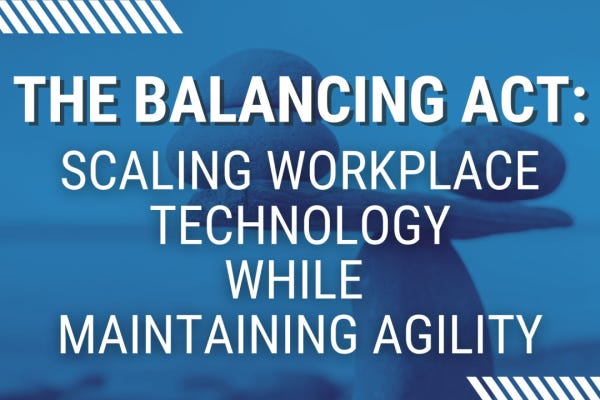The Balancing Act: Scaling Workplace Technology While Maintaining Agility
Expand your technology infrastructure without losing the flexibility that drives your organization’s success.
The ability to scale workplace technologies that address efficiency, engagement, and innovation is a critical step at any stage of growth. But scaling comes with the risk of losing the very agility that enables organizational success in the first place.
Implementing a new Intranet, ERP, or data management system (especially if you’re considering any AI component) may be intended for better communication and collaboration. But in my experience, if the process is not done well, it can leave employees feeling less connected and engaged — ultimately affecting their ability to pivot quickly, make swift decisions, and adapt to market changes.
Addressing both organizational and employee needs for technology that makes things easier, with the agility to keep doing things as fast as possible, is a delicate balancing act.
The key to scaling technology while maintaining agility requires a clear strategy for discovery, implementation, and change management. Using this structure will also enable you to achieve your goals faster — ensuring your teams quickly, and effectively, get access to the tools they need to continue driving growth.
Discovery: Identifying Critical Needs
Before embarking on the journey of scaling your technology, it’s essential to prioritize your critical needs. Over-engineering can lead to complexity and reduce your ability to adapt quickly. When able, start small to establish a strong foundation, and build up from there. Here are some steps to help you focus on what truly matters:
Conduct a Needs Assessment: Start by evaluating your current technology stack and identifying gaps that hinder your growth. Engage with different teams to understand their pain points and requirements.
Set Clear Priorities: Once you’ve identified the gaps, prioritize them based on their impact on your business goals. Focus on solutions that provide immediate value and scalability, establish a well-defined roadmap with timelines for the rest.
Avoid Over-Engineering: Resist the temptation to build overly complex systems. Simplicity often leads to better performance and easier maintenance.
Plan for Future Growth: While addressing current needs, keep an eye on the future. Choose extensible solutions, ones that can grow with your business without requiring significant overhauls. For this reason, if possible, consider SaaS before custom builds.
Implementation: Adopting Flexible Solutions
Flexibility is key to maintaining agility while scaling. Leveraging cloud-based services and modular tech stacks can provide the flexibility needed to adapt to changing demands. Here are some approaches:
Cloud-Based Services: Cloud platforms like Microsoft SharePoint, and Google Workspaces offer scalable solutions that can be adjusted based on your needs. They allow you to scale up or down without significant capital investment.
Modular Tech Stacks: Adopt a modular approach to your technology stack. Break down your systems into smaller, independent services that can be developed, deployed, and/or scaled independently.
API-Driven Architecture: Use APIs to integrate systems and services. This approach allows you to utilize existing tools and systems, and swap out or upgrade individual components, without disrupting the entire pre-existing workflow.
Microservices: Implement microservices architecture to enable rapid development and deployment cycles. Each microservice can be scaled independently, providing greater flexibility.
Change Management
Agile practices are crucial for preserving your company’s nimbleness. Continuous integration and delivery, along with small, cross-functional teams, can help maintain this agility. Here’s how to do it:
Continuous Integration and Delivery (CI/CD): Implement CI/CD pipelines to automate testing and deployment. This approach reduces the time between development and production, allowing for faster iterations.
Small, Cross-Functional Core Teams: Keep your core and department teams small and cross-functional. Each team should have the necessary skills to develop, test, and deploy features independently. A small core team should represent an understanding of the larger needs. These structures promote quick decision-making and reduces dependencies.
Regular Retrospectives: Conduct regular retrospectives to identify what’s working and what’s not. Encourage teams to experiment with new processes and technologies to find the best approach that fits their team’s needs and style of working.
Lean Methodologies: Embrace lean methodologies to eliminate waste and focus on delivering value. Prioritize tasks that directly contribute to your business goals, continuously improve your processes, and address problems quickly to learn from mistakes.
Scaling technology while maintaining agility is indeed a balancing act, but it’s not an impossible one. By identifying your critical needs, adopting flexible solutions, and maintaining agile practices, you can expand your technology infrastructure without losing the flexibility that drives your success. Remember, the goal is to grow while staying nimble enough to adapt to the inevitable change.



